Vesicles
Blisters
A vesicle is a small fluid-filled blister on the skin.
Images
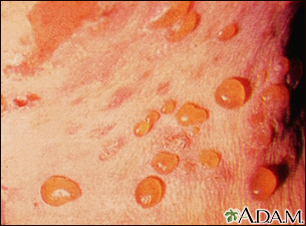
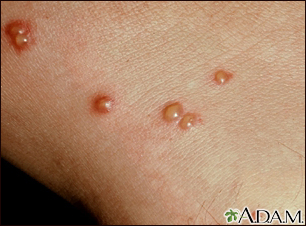
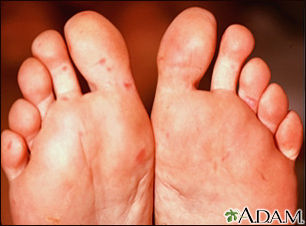
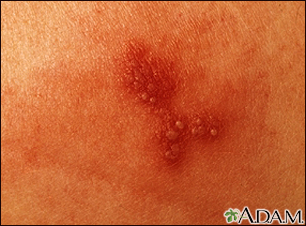
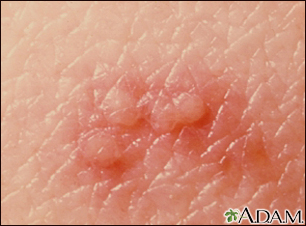
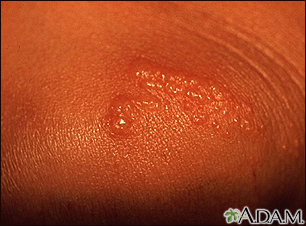
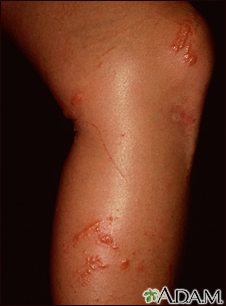
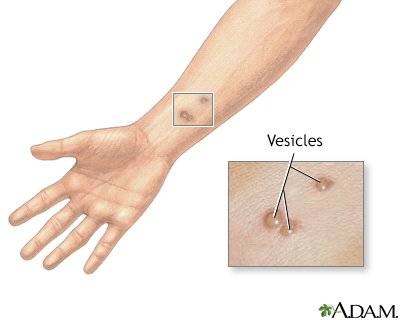
I Would Like to Learn About:
Considerations
A vesicle is small. It may be as tiny as the top of a pin or up to 5 millimeters wide. A larger blister is called a bulla.
In many cases, vesicles break easily and release their fluid onto the skin. When this fluid dries, yellow crusts may remain on the skin surface.
Causes
Many diseases and conditions can cause vesicles. Common examples include:
- Allergic reactions to drugs
- Atopic dermatitis (eczema)
- Autoimmune disorders such as bullous pemphigoid or pemphigus
- Blistering skin diseases including porphyria cutanea tarda and dermatitis herpetiformis
- Chickenpox
- Contact dermatitis (may be caused by poison ivy)
- Herpes simplex (cold sores, genital herpes)
- Herpes zoster (shingles)
- Bacterial infections
- Fungal infections
- Burns
- Friction
- Treatment with cryotherapy (to treat a wart for example)
Home Care
It is best to have your health care provider examine any skin rashes, including vesicles.
Over-the-counter treatments are available for certain conditions that cause vesicles, including poison ivy and cold sores.
When to Contact a Medical Professional
Call your provider if you have any unexplained blisters on your skin.
What to Expect at Your Office Visit
Your provider will look at your skin. Some vesicles can be diagnosed simply by how they look.
In many cases, additional tests are needed. The fluid inside a blister may be sent to a lab for closer examination. In particularly difficult cases, a skin biopsy may be needed to make or confirm a diagnosis.
Treatment will depend on the cause of the vesicles.
Related Information
BullaeMacule
Papule
Pustules
References
Dinulos JGH. Vesicular and bullous diseases. In: Dinulos JGH, ed. Habif's Clinical Dermatology. 7th ed. Philadelphia, PA: Elsevier; 2021:chap 16.
Marks JG, Miller JJ. Vesicles and bullae. In: Marks JG, Miller JJ, eds. Lookingbill and Marks' Principles of Dermatology. 6th ed. Philadelphia, PA: Elsevier; 2019:chap 10.
BACK TO TOPReview Date: 6/7/2023
Reviewed By: Elika Hoss, MD, Assistant Professor of Dermatology, Mayo Clinic, Scottsdale, AZ. Also reviewed by David C. Dugdale, MD, Medical Director, Brenda Conaway, Editorial Director, and the A.D.A.M. Editorial team.

Health Content Provider
06/01/2025
|
A.D.A.M., Inc. is accredited by URAC, for Health Content Provider (www.urac.org). URAC's accreditation program is an independent audit to verify that A.D.A.M. follows rigorous standards of quality and accountability. A.D.A.M. is among the first to achieve this important distinction for online health information and services. Learn more about A.D.A.M.'s editorial policy, editorial process and privacy policy. A.D.A.M. is also a founding member of Hi-Ethics. This site complied with the HONcode standard for trustworthy health information from 1995 to 2022, after which HON (Health On the Net, a not-for-profit organization that promoted transparent and reliable health information online) was discontinued. |
The information provided herein should not be used during any medical emergency or for the diagnosis or treatment of any medical condition. A licensed medical professional should be consulted for diagnosis and treatment of any and all medical conditions. Links to other sites are provided for information only -- they do not constitute endorsements of those other sites. © 1997- 2025 A.D.A.M., a business unit of Ebix, Inc. Any duplication or distribution of the information contained herein is strictly prohibited.
